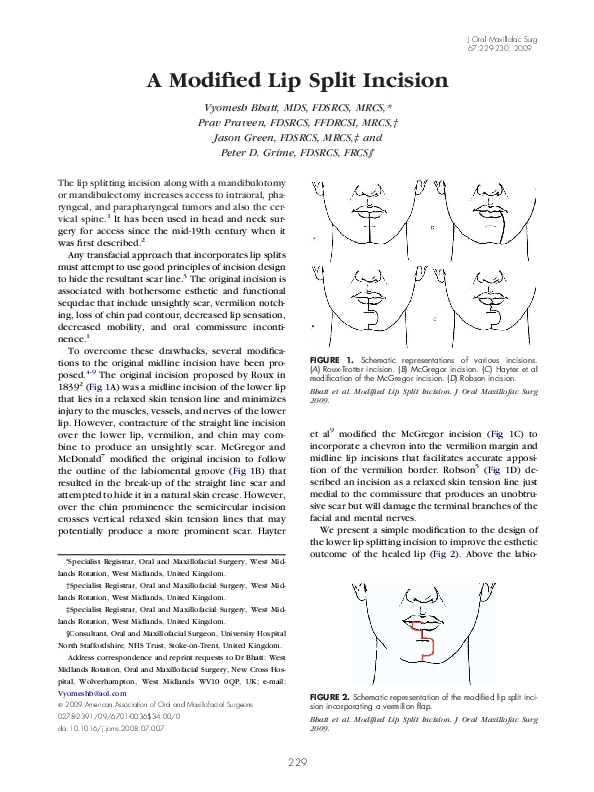Academia.edu no longer supports Internet Explorer.
To browse Academia.edu and the wider internet faster and more securely, please take a few seconds to upgrade your browser.
A Modified Lip Split Incision
Related Papers
The open mouth provided the basis for various surgical approaches to tumors of the oral cavity. If this access is inadequate it is generally added to by splitting the lower lip in the mid line. Roux in mid-19th century first described lower lip splitting procedure which was later modified by Trotter and Konig. Midline vertical incision may cause scar contractures and notching at the vermillion cutaneous border and results in disruption of the round smooth chin pad counter. This study includes patients who were diagnosed to be having oral squamous cell carcinoma in which lip split approach was used to access tumor. From the present study, it becomes apparent that chin appearance and chin pad counter becomes a standalone criteria in clinical comparison of Roux-trotter and McGregor incision. In our experience, McGregor incision with lateral modification in the neck is the one that poses the fewest problems and produces the best cosmetic results as compared to Roux-Trotter.
Functional and Aesthetic Results of Various Lip-Splitting Incisions: A Clinical Analysis of 60 Cases
Functional and Aesthetic Results of Various Lip-Splitting Incisions: A Clinical Analysis of 60 Cases2001 •
This study retrospectively evaluated the functional and aesthetic results of various types of lip-splitting incisions in a group of patients in whom this approach was used to treat intraoral tumors. Patients and Methods: Between 1992 and 1998, 87 consecutive patients were subjected to either mandibulotomy or mandibulectomy using a lip-splitting incision. During this period, 4 types of incisions were sequentially used: straight midline incision, lateral lip-splitting incision, midline splitting with extension around the contour of the chin, and the chevron chin-contour incision. Sixty patients with a follow-up of at least 6 months were included in the study. The patients were asked to answer a questionnaire regarding the degree of satisfaction with the cosmetic result of the procedure and were clinically assessed for sensory and functional impairment resulting from the incision. The remaining 27 patients were lost to follow-up or had died of their disease. Results: The lateral lip-splitting incision caused the fewest postoperative problems in patients subjected to either mandibulotomy or mandibulectomy. The best overall results were achieved by the chevron-chin contour incision. The incision that followed the contour of the chin and the straight midline incision showed less satisfactory results. Conclusion: The chevron chin-contour incision, along with meticulous soft tissue closure, produces the best aesthetic and functional results.
Oral Surgery
Effects of incisions made with electrocautery and scalpel on upper lip length: a pilot study2011 •
Clinical Otolaryngology
An anatomical comparison of Blair and facelift incisions for parotid surgery2006 •
Annals of Plastic Surgery
One Stage Aesthetic and Functional Reconstruction of Major Lower Lip Defects2017 •
World journal of plastic surgery
Absence of the Labiomental Groove: A Common but Preventable Unpleasant Aesthetic Problem of the Lower Lip-Chin Burn Reconstruction2017 •
Archives of plastic surgery
Lower lip reconstruction after wide excision of a malignancy with barrel-shaped excision or the webster modification of the bernard operation2013 •
Because there are numerous methods for reconstruction of the lower lip, it is not easy to choose the optimal method. In choosing the surgical method for lower lip reconstruction, we obtained acceptable outcomes based on our treatment strategy, which included either a barrel-shaped excision or the Webster modification of the Bernard operation. We report on the surgical outcomes based on our treatment strategy. This study included 26 patients who underwent lower lip reconstructive surgery from September 1996 to September 2010. The operation was done using either a barrel-shaped excision or the Webster modification, considering the location of the defect, the size of the defect, and the amount of residual tissue on the lateral side of the vermilion after excision. In our series, 3 patients underwent a single barrel-shaped excision, and nine patients underwent a double barrel-shaped excision. In addition, the unilateral Webster modification was performed on in 6 patients, and there were...
Egyptian Journal of Oral and Maxillofacial Surgery
Modification of Marking Procedure in Anatomical Subunit Approximation Technique in Treatment of Unilateral Cleft LipJournal of the American Academy of Dermatology
Second intention healing for intermediate and large postsurgical defects of the lip2007 •
RELATED PAPERS
Estudios de Derecho Procesal y Litigación
El interrogatorio de peritos2024 •
2024 •
Puslu Mantık ve Kuantum Mekaniği'ndeki Belirsizlik İlkesi
Uluslararasi-Istanbul-Felsefe-Kongresi-Bildiri-Kitabi-Cilt5-Çağdaş-Mantik-Tartismalari2019 •
Συμβούλιο Διεθνών Σχέσεων, το Ίδρυμα Αικατερίνη Λασκαρίδη, και οι Εκδόσεις Δίαυλος, 8 Φεβρουαρίου, 2024
Ο Νέος Ψυχρός Πόλεμος: Γεωπολιτικός ανταγωνισμός ΗΠΑ-ΚίναςClassical quarterly
‘Day Watch’ or Baywatch? A Note on Ημεροσκοποσ (Ar. Lys. 849)2021 •
Sociétés Politiques Comparées. FASOPO
"L' Algérie française", un crime presque parfait. Dispositifs et récits de la relaxe2023 •
Economics, Management and Sustainability
Exploring the nexus between banking stability and market value: Evidence from the Iraqi banking sector2024 •
Public Health Reports
Striving to Meet Healthy People 2020 Objectives: Trend Analysis of Maternal Smoking2018 •
Journal of Organic Chemistry
Oteromycin: A Novel Antagonist of Endothelin Receptor1995 •
2018 •
Optics Communications
Gold-coated photonic crystal fiber based polarization filter for dual communication windows2020 •
Evropský politický a právní diskurz
Evolution of Punishment in 21st Century: New Perspectives for Research2024 •
2017 10th International Symposium on Advanced Topics in Electrical Engineering (ATEE)
Power flow management in three port converter using PV panel with maximum power point tracker2017 •
Infection Control & Hospital Epidemiology
Use of leading practices in US hospital antimicrobial stewardship programs2001 •
International journal of pharmacognosy and life science
Formulation and evaluation of hair fall control herbal hair oil2023 •
RELATED TOPICS
- Find new research papers in:
- Physics
- Chemistry
- Biology
- Health Sciences
- Ecology
- Earth Sciences
- Cognitive Science
- Mathematics
- Computer Science

 Vyomesh Bhatt
Vyomesh Bhatt